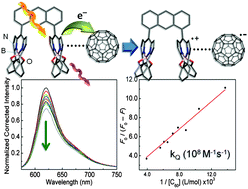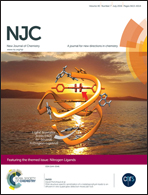The first example of cofacial bis(dipyrrins)†
Abstract
Two series of cofacial bis(dipyrrins) were prepared and their photophysical properties as well as their bimolecular fluorescence quenching with C60 were investigated. DFT and TDDFT computations were also performed as a modeling tool to address the nature of the fluorescence state and the possible inter-chromophore interactions. Clearly, there is no evidence for such interactions and the bimolecular quenching of fluorescence, in comparison with mono-dipyrrins, indicates that C60-bis(dipyrrin) contacts occur from the outside of the “mouth” of the cofacial structure.

- This article is part of the themed collection: Nitrogen Ligands

 Please wait while we load your content...
Please wait while we load your content...